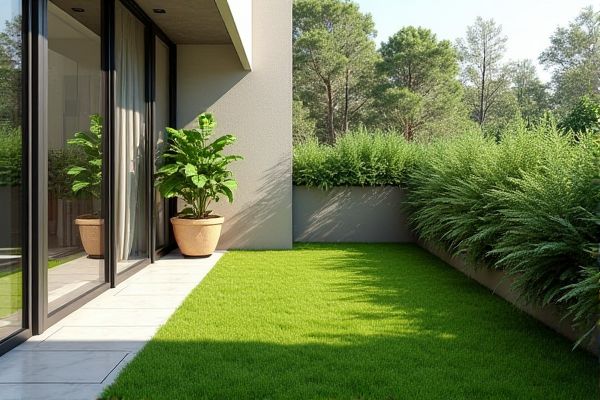
Faux grass offers low maintenance and year-round greenery for balconies, while real grass provides natural texture and environmental benefits but requires more care and watering. Explore this article to discover which option best suits your balcony and lifestyle needs.
Table of Comparison
| Feature | Faux Grass | Real Grass |
|---|---|---|
| Maintenance | Low maintenance; no watering or mowing needed | High maintenance; requires regular watering, mowing, and fertilizing |
| Durability | Highly durable; withstands foot traffic and weather | Less durable; can wear out and turn patchy |
| Appearance | Consistent green color year-round | Natural look but changes with seasons and health |
| Installation | Easy and quick installation | Requires soil preparation and planting time |
| Environmental Impact | No water usage; made from synthetic materials | Supports biodiversity; oxygen production; requires water |
| Cost | Higher initial installation cost; low ongoing costs | Lower initial cost; ongoing maintenance costs higher |
| Comfort | Soft but can get hot in direct sunlight | Cool and natural feel |
Introduction to Balcony Grass Options
Balcony grass options include faux grass and real grass, each offering distinct advantages for urban outdoor spaces. Faux grass provides low-maintenance, weather-resistant greenery that stays lush year-round without watering or mowing. Real grass enhances natural ambiance and air quality but requires regular care, sunlight, and proper drainage to thrive in balcony settings.
Overview of Faux Grass for Balconies
Faux grass for balconies offers a low-maintenance, durable alternative to natural turf, providing a green aesthetic year-round without the need for watering, mowing, or fertilizing. Made from synthetic fibers designed to mimic the look and feel of real grass, it is resistant to weather conditions and pet-friendly, making it ideal for urban living spaces. Installation is straightforward, often involving a simple roll-out process over existing balcony floors, enhancing comfort and reducing dirt and allergens.
Real Grass Benefits and Drawbacks
Real grass on your balcony offers natural beauty, improved air quality, and a cooling effect due to its ability to absorb heat, enhancing outdoor comfort. However, it demands regular watering, sunlight, and maintenance, which can be challenging in limited balcony spaces. Pest issues and potential damage to balcony surfaces are additional considerations when opting for real grass.
Installation Process: Faux Grass vs Real Grass
Faux grass installation on balconies involves laying pre-cut synthetic turf over a clean, flat surface, often with an adhesive or interlocking system, allowing for quick and low-maintenance application. Real grass requires soil preparation, seed planting or sod laying, and periodic watering, fertilizing, and drainage management to ensure healthy growth in limited balcony spaces. The synthetic option eliminates the need for extensive upkeep and adapts easily to varying balcony sizes, while natural grass demands ongoing care and environmental considerations.
Maintenance Requirements Compared
Faux grass on balconies requires minimal maintenance, eliminating the need for watering, mowing, or fertilizing, which suits busy urban lifestyles. Real grass demands consistent care such as regular watering, trimming, and protection from pests to maintain a healthy appearance in limited sunlight. Opting for faux grass significantly reduces labor and resource use, making it an efficient choice for low-maintenance balcony greenery.
Longevity and Durability Factors
Faux grass offers superior longevity and durability on balconies due to its resistance to weather elements, UV rays, and heavy foot traffic without fading or patching. Real grass requires constant maintenance, including watering, fertilizing, and sunlight, and is prone to wear, disease, and browning over time in balcony settings. Synthetic turf materials like polyethylene and polypropylene enhance faux grass durability, making it a practical and long-lasting alternative for balcony landscaping.
Environmental Impact: Artificial vs Natural
Faux grass on your balcony reduces water consumption and eliminates the need for pesticides, minimizing chemical runoff and conserving natural resources. Real grass supports urban biodiversity by providing habitat for insects and helps absorb carbon dioxide and pollutants, contributing to improved air quality. Choosing between artificial and natural grass involves balancing environmental benefits such as resource conservation with ecological contributions.
Cost Analysis: Initial and Ongoing Expenses
Faux grass for balconies requires a higher initial investment, typically ranging from $8 to $15 per square foot, but offers minimal ongoing maintenance costs like occasional cleaning and no watering expenses. Real grass has a lower upfront cost, around $3 to $6 per square foot for sod, but incurs continuous expenses such as watering, fertilizing, mowing, and pest control, which can add significantly to your long-term budget. Your decision should weigh the upfront affordability of real grass against the cost savings over time with faux grass maintenance.
Aesthetic Appeal and Comfort
Faux grass offers a consistently lush and vibrant appearance on your balcony without the seasonal browning or patchiness of real grass, maintaining a pristine look year-round. It provides a soft, cushioned surface that feels comfortable underfoot, requiring no watering or mowing, which enhances convenience and usability. Real grass, while naturally cooling and emitting fresh scents, can be uneven and patchy, potentially reducing comfort and aesthetic appeal in small balcony spaces.
Which Grass Type is Best for Your Balcony?
Faux grass offers low maintenance and durability, making it ideal for small balconies with limited sunlight and water access. Real grass requires regular watering, sunlight, and soil care, which can be challenging in balcony environments but provides natural aesthetic and improved air quality. Choose faux grass for convenience and longevity or real grass for a natural feel if conditions allow ample light and maintenance.
 homyna.com
homyna.com